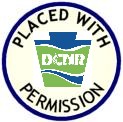As you hike the trail you will see numerous depressions from the
railroad ties which are long gone. The cache is located in an area
that we call “Blueberry Flats”. We don’t know exactly how many
acres the “Flats” are but the area is primarily covered with wild
blue berries that generally ripen in mid July to early August.
This is a brief history of logging in the area. In 1794, Daniel
Delany surveyed the impressive forests of white pine, hemlock and
scattered hardwoods. Logging began slowly as small sawmills
processed the wood. The light, strong wood of the white pine made
it the jewel of early lumbering. Ship builders in Baltimore prized
tall white pine logs for ship masts and paid premium prices.
Loggers built white pine rafts and rode them down the Susquehanna
River. When all went well, loggers arrived in Baltimore to sell
their highly valued logs. Logging accelerated in 1851 because of a
log boom built across the West Branch of the Susquehanna River at
Williamsport. The boom stopped floating logs for sorting and
cutting by sawmills. Upriver, "woodhicks" felled trees, cut off
their branches and marked each log with the seal of the lumber
company that employed them. Most logging occurred in winter, when a
thick layer of snow and ice made hauling easier. Woodhicks built
wooden log slides on hillsides to easily move logs to temporary
pools called splash dams. A reproduction log slide and early
lumbering tools can be seen on the Log Slide Trail. Splash dams
were released each spring to float logs down Laurel Run to
Bennett's Branch, then to Sinnemahoning Creek, and then into the
West Branch of the Susquehanna River for their journey to the
sawmills at Williamsport. Full-scale lumbering in the area probably
began around 1870. The park takes its name from William Parker, who
leased lumbering rights from John Otto. Parker built a splash dam
on Laurel Run at the site of the present lake. The forests were cut
and recut, first for the white pine and later for hemlock and
hardwoods. In the early 1900s, the log boom at Williamsport became
inefficient when geared locomotives moved the logs directly from
the forests to the mills. By 1911, the log boom was dismantled and
the Central Pennsylvania Lumber Company built logging railroads and
logged the land a final time. Crews loaded up to 45 railroad cars a
day until logging ended in 1912. Look for old railroad grades still
visible on Moose Grade Road and Beaver Dam and Quehanna hiking
trails. For nearly two decades after the last tree was felled,
fires and floods wreaked havoc.
There are 3 routes to the cache. Your route depends on how
adventurous you are. The shortest route is from Harley Dean Road,
but this can be a difficult bushwack during the summer months and
crosses through some terrain that looks real inviting for
slithering invertebrates. The route from Four Mile Road takes you
through an area of Mountain Laurel that is beautiful when it is in
bloom. This route can be a little tricky due to a swampy area that
is home to a family of beavers. We prefer the route from the
intersection of Laurel Run Road and Laurel Ridge Road. Whatever
route you choose, bring along insect repellent during the summer
months, you’ll be glad you did. This is State Forest land and this
area sees a lot of hunting activity during regular hunting season,
so please wear the State mandated amount of Blaze orange during
hunting season. The trail has been open to snowmobiles in the past
so winter access is possible via snowmobile during snowmobiling
season.
Please check forestry maps and local snowmobile maps, before
heading out, to verify that the trail is open for snowmobile
use.

Click
Here for details